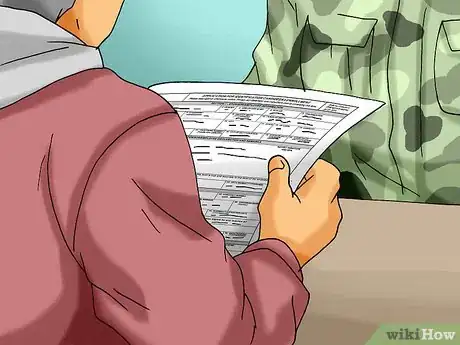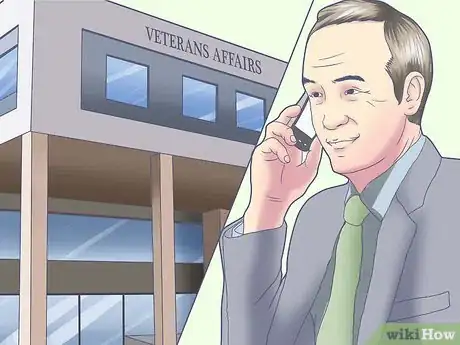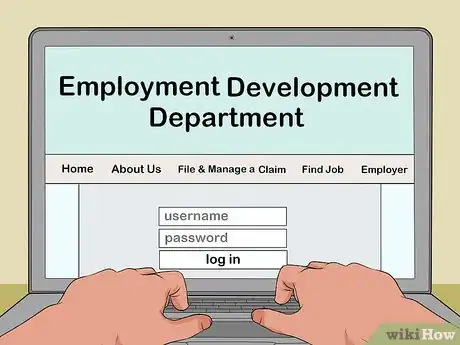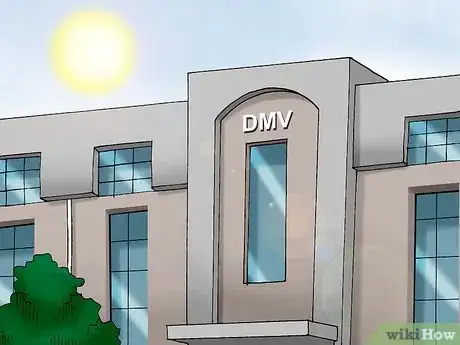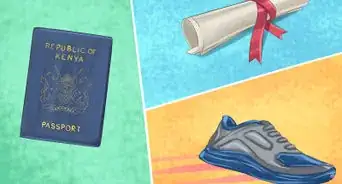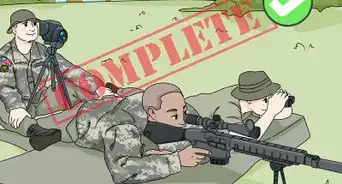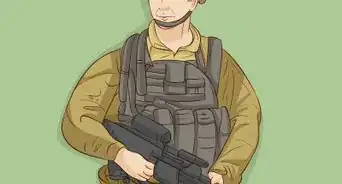X
wikiHow is a “wiki,” similar to Wikipedia, which means that many of our articles are co-written by multiple authors. To create this article, volunteer authors worked to edit and improve it over time.
This article has been viewed 29,206 times.
Learn more...
Separating from Active Duty in the U.S. Army is a process that starts around one to two years from your separation date. As you approach your separation date the process grows in intensity, especially at the ninety-day mark.
Steps
Part 1
Part 1 of 5:
Handling Administrative and Financial Duties
-
1Take a trip to your local S1 (unit administrative office) between 120 and 90 days before your separation with leave. The S1 office will make sure your administrative documents are up to date and give you a separation orders packet that you will need to fill out, gather required documents, and return promptly. The quicker you turn in this packet, the sooner S1 will send it to the Post Transitions Center. After the Post Transitions Centers receives your packet, they will e-mail your separation orders to your official military e-mail within 30 days. If you did not receive your orders within 30 days inquire with both your S1 and the Post Transitions Center.
- The Post Transition Center will usually not process your orders before 90 days of your separation. The 90 days starts from your anticipated leave start date and not your official ETS.
-
2Check to make sure the information on your Soldier Record Brief is correct. The Soldier Record Brief is commonly known as the SRB, ERB, or ORB. The most important document after your military career is the Certificate of Release or Discharge from Active Duty (DD Form 214). You will use the DD Form 214 for everything that requires proof of your military service. This form is automatically generated from the same system that creates your SRB. You will meet with a transitions counselor to go over and sign the DD Form 214 about a week before separation but having an up to date SRB will ensure a much smoother process.
- Some veteran benefits require service in a combat theater which can be proved on your DD Form 214 with either the corresponding campaign medal (DD Form 214 Block 13) or by deployment dates (DD Form 214 Block 18).
Advertisement -
3Schedule an appointment with your Post Finance Office. Before separating you will need to discuss your final pay check with a finance counselor. This will most likely be done in a group setting a week before you separate, but you can schedule an appointment to go over finances in advance to the group meeting. Most of your final pay will be calculated automatically; however, you will have to gather the following items:
- Signed Leave Form (DA Form 31, available at https://armypubs.army.mil/pub/eforms/DR_a/pdf/ARN6954_A31_Final.pdf)
- Send this form through your chain of command 90 days before your leave start date. If taking less than 30 days your company level commander may sign, if taking more than 30 days you will need the signature of your battalion level commander.
- Special Pay Logs
- Finance will request all logs that go along with special pays you may be receiving (i.e. Jump Pay and/or Flight Pay). This is to ensure you met the appropriate criteria for every month you received the special pay. You will need to be current up to your official ETS date, or you will have those special pay benefits deducted for the months you aren’t covered.
- Signed BAH Authorization (DA Form 5960) for single soldiers if taking leave
- Single soldiers are entitled to BAH (Basic Allowance for Housing) while on leave if they relinquish their post quarters. If you are separating state-side you will receive BAH pay based off your duty location. If separating overseas you will receive BAH pay based off your HOR. Likewise, make sure your S1 stops your meal card deductions with the Finance office. Depending on the post location, some finance offices will have an officer present to sign the form, while others will want your company commander to sign the form.
- Signed Leave Form (DA Form 31, available at https://armypubs.army.mil/pub/eforms/DR_a/pdf/ARN6954_A31_Final.pdf)
-
4Prepare to clear your installation and unit. Between 30 days and two weeks you will pick up your installation clearing papers (DA form 137-2) from the transition center. Separation orders are required to pick up your clearing papers. Proceed to every station required by you on the form to clear your military installation. At the same time, you will want to pick up unit clearing papers (DA Form 137-1) from your S1. Unit clearing papers have the exact same process as the installation clearing papers
- Examples of these forms are available at https://armypubs.army.mil/pub/eforms/DR_a/pdf/ARN8259_A137-1_final_re.pdf and https://armypubs.army.mil/pub/eforms/DR_a/pdf/A137_2.pdf - Use these two forms as examples only. Your clearing paper stations will depend on your clearing installation and unit. They will be provided to you during the separation process.
-
5Clean all of your issued gear for turn-in. Most installations will allow you to turn in issued gear at the 30-days from your leave start date with separation orders and DA Form 31 on hand. You will be required to clean your gear. Look to see if your post has a quartermaster. They will clean your gear and issue a receipt. Bring the receipt and the turn-in facility will be required to take your gear, regardless of its condition. Make sure to call the turn-in facility whenever you receive your separation orders to schedule an appointment. You can view your military clothing record on AKO. Go to links and click on “My Clothing Record”. You will be required to clean and turn in everything that has a “N” under “ETS TRAN”.
-
6Be Ready to serve in the Individual Ready Reserve (IRR).[1] Depending on your length of service you may have commitment to the Individual Ready Reserve. Both your separation orders and your DD 214 will display your remaining commitment to the IRR. In the IRR you are simply required to keep up to date contact information with the reserve unit, which will contact you at some point after separation. While in the IRR you are subject to in-voluntary recalls to deployment and muster duties. In the IRR you have several benefits readily available to you. They include but are not limited to:
- Reservist ID Card
- Post Exchange (PX) and Commissary Benefits
- Leadership Schools and Promotions
- Deployment Opportunities
Advertisement
Part 2
Part 2 of 5:
Handling Medical Duties
-
1Schedule a separation physical exam at your unit’s health care facility. The Army requires a physical exam prior to separation. Commonly known as Final Physical, or Phase II Physical. The physical exam will cover a brief history of any medical related incidents during your service to the Army. It is important to document with your Physician Assistant any medical problems you might be currently experiencing. Prior to being screened by your PA you will have to fill out DD Form 2808. Most units allow one to begin their separation exam when they’re 90-days from their leave start date.
-
2Order your medical records from your unit’s health care facility. You may have to go to multiple medical facilities depending on your medical history. The records are available for your own safekeeping, and for Veterans Affairs. You will want to order you records after your separation exam as your Physician Assistant could request more follow-up exams.
-
3Schedule a medical claim appointment at your Post Veterans Affairs office at 120 days from your separation date. If you don’t have any present medical issues you may still be eligible for VA healthcare. It is highly beneficial to schedule your VA claim appointment at 120 days from separation as you will qualify for the VA benefits on discharge program. If you have less than 90 days remaining you can still file for a VA medical claim, albeit the process will take longer and require VA appointments outside of the Army and it may be several months before you can collect disability.
- The VA benefits on discharge program allows you to conduct all your VA medical appointments while still serving on active duty.[2] You will also start collecting any disability you may qualify for upon separation from the Army. You must have 90 days remaining on Active Duty to qualify for this program.
-
4Register in the VA Healthcare Airborne Hazards and Open Burn Pit Registry. Registering for this program documents your health now and allows you to update any further changes to your health that might be dependent on airborne hazards. This program is for veterans who deployed to Afghanistan, The Middle East, and Southwest Asia. To register follow this official government link: https://veteran.mobilehealth.va.gov/AHBurnPitRegistry/#page/home.
Advertisement
Part 3
Part 3 of 5:
Transporting to Your Home of Record (HOR) or Home of Selection (HOS)
-
1Figure out how you will move your belongings after you separate from the Army. If you served less than eight years of continuous Active Duty the Army will only move your household goods (personal belongings) to your HOR. If you served for more than eight years continuously then the Army will move your household goods to your HOS. You will be given the choice of allowing the Army to hire professional movers to move your household goods, receiving a monetary allotment based off weight to move household goods on your own accord, or a combination of both.
- Household Goods shipment will be available through your Post Transportation Office. Gas, Mileage, and Lodging reimbursement commonly known as Per Diem and MALT will be done through the Post Finance Office.
- Moving your household goods on your own accord is known as Personally Procured Move (PPM). For a full reimbursement you will need to fill out a Travel Voucher (DD Form 1351-2, available at http://www.esd.whs.mil/Portals/54/Documents/DD/forms/dd/dd1351-2.pdf) and collect necessary documents such as rental contracts, weight tickets, and separation orders. Your Post Transportation Office will provide you with a PPM packet.
-
2Decide on what mode of transportation you will take to get home. As a separating soldier you are entitled to Gas, Mileage, and Lodging reimbursement based off the total distance to your HOR or HOS, known as MALT and Per Diem. You may forgo the following and request a one-way plane ticket to your HOR.
- Requesting a plane ticket will be done at your Post Transportation Office.
- For Gas, Mileage, and Lodging reimbursement you will have to fill out a travel voucher (DD Form 1351-2) and collect necessary documents. Your Post Finance Office will provide you with a Per Diem/Malt packet. The general rule of thumb is you will be paid up to 350 miles (560 km) per day, up to the authorized mileage for your trip.
Advertisement
Part 4
Part 4 of 5:
Attending Civilian Employment and Education Transition Workshops
-
1Attend the mandatory one-week Soldier for Life Workshop. Around 12 months from your separation date you will want to schedule the Soldier for Life Workshop. This workshop is mandatory and covers civilian employment, education opportunities, and Veteran Affairs Benefits.
-
2Enroll in various employment workshops based off your future career path. The Army will pay for several employment workshops while on Active duty and up to six months after separation. Many of these programs will guarantee a job upon completion. Plan ahead as some of these programs will run the course of six months. Some notable examples include:
- CDL Licensing
- A+, Security+, Network+, and other IT related certificates.
- EMT Certification
- Microsoft Software and Systems Academy
-
3Apply to the school of your choice while still on Active Duty. If you plan to go to school research the college of your choice and the application deadlines. Majority of schools have deadlines from Jan. 1st to Feb. 1st, for the following Fall through Spring academic school year. As such you will need to have your application turned in nine months in advance for priority enrollment.
-
4Update and apply for VA education benefits. Check with a VA counselor prior to separation to make sure you are properly enrolled into the GI Bill Programs. You can switch between GI Bills on the official VA website. Do note that you can only make this change once.
- There are two GI Bills you may qualify for, The Post 9/11 GI Bill, and the Montgomery GI Bill-Active Duty (MGIB).
- The Montgomery GI Bill provides a check for each month you are in school. This check is meant to cover your tuition expenses.
- The Post 9/11 GI Bill will pay the institution of learning directly for tuition costs. Additionally, a student will receive a monthly housing allowance dependent on the school area, and a yearly book stipend.
- You can use the calculator at https://www.vets.gov/gi-bill-comparison-tool to estimate your GI Bill benefit amount, dependent on your school of choice.
-
5Apply for Unemployment Insurance. Recently discharged veterans qualify for unemployment within every state. You may not be able to enroll until after you are officially separated from the Army. Most unemployment programs will require you to actively search for employment and some will deny unemployment if attending school. Visit your states unemployment website for more information.
Advertisement
Part 5
Part 5 of 5:
Handling Civilian Transition Duties
-
1Update your address. You will want to update your address to your new residency. Common places to update your address include:
- Financial Institutions
- Insurance Companies
- Department of Motor Vehicles
- Post Office
- Online Services
- Utility Companies
- Veterans Affairs
-
2Update your insurance policies. After you separate from the Army your enrollment in Tricare will immediately end. To stay covered you will need to find a new health insurance policy. Life insurance in the Army known as SGLI only lasts for 120 days after separation. Afterwards you will want to enroll in a new life insurance policy at your own discretion.
-
3Update your driver’s license and registration. If you are moving states you will be required to update your driver’s license and registration to that of your new state. Some states will require you to mail back your registration and/or license plate. Check your state’s DMV webpage for details.
Advertisement
References
- ↑ https://www.hrc.army.mil/content/Individual%20Ready%20Reserve%20(IRR)~2F%20IMA%20Program%20Management%20(IMA)
- ↑ https://benefits.va.gov/predischarge/claims-pre-discharge-benefits-delivery-at-discharge.asp
- https://www.dfas.mil/militarymembers/travelpay/armypcs.html
- https://www.defensetravel.dod.mil/Docs/perdiem/JTR.pdf (13 MB PDF File)
- https://www.move.mil/moving-guide/retirees-separatees
About This Article
Advertisement

